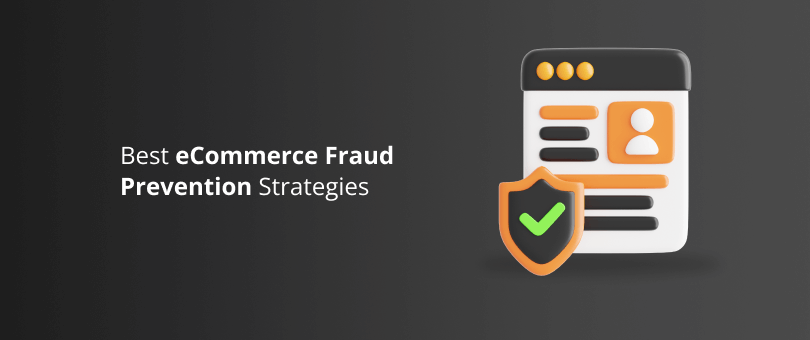Fraud is a major challenge for eCommerce businesses and has led to significant financial losses worldwide. In 2022, online brands experienced approximately $41 billion globally in losses, and this number was expected to rise to $48 billion in 2023.
Moreover, the impact of deception goes beyond financial implications. It also harms the buyer experience and damages brand reputations. A survey found that 66% of American consumers would not make future purchases from an online store if their account had been compromised.
To protect your business from eCommerce fraud, it is important not only to be informed but it’s imperative that you implement protective measures.
In this article, we will be discussing the most common types of deceit, prevention strategies, and what tools are necessary to help you combat it . Keep on reading.
Readers Also Enjoy: 10 Bold Ways to Use AI in Ecommerce – DevriX
What Is eCommerce Fraud?
Ecommerce fraud in retail is a criminal act that happens when scammers manipulate a transaction from an online store to steal from the customer, the seller, or both. It’s also called payment fraud.
With global eCommerce sales expected to hit a whopping $6.3 trillion in 2024, impostors have lots of chances to snatch customer info and pull off their schemes.
Reasons for Ecommerce Fraud
There are a few main reasons this problem exists:
- Weak credentials. Users’ credentials are often stolen through phishing attacks or weak passwords.
- Data breaches. Hackers gain access to a company’s digital network and steal customer information. Unauthorized purchases are often made using this stolen information.
- Lack of secure payment verification. Without tools like two-factor authentication or CVV card verification, it’s easier for scammers to use stolen card information to make purchases.
- Inadequate website security. Weaknesses in website security can be used to perform tactics to bypass security measures or inject malware into websites.
- Advanced persistent threats (APTs). The intruders gain access to a network and stay undetected for a long time. APTs can be used in e-commerce to gather a lot of customer data over time, leading to scam.

Most Common eCommerce Frauds
Stealing Credit Card Information
Credit card numbers and personal information are obtained illegally in several ways. Hackers can breach company data systems and steal customer payment details. Skimming devices can be installed on ATMs or payment terminals to copy card and PIN information. Deceptive phishing emails pretend to be from a trusted source to trick people into entering private data that is captured. The stolen card details are then used to make unauthorized purchases or sold on the dark web.
Tricking People to Share Private Details
Tricksters can use social engineering tactics and technical subterfuge. Phishing emails and smishing texts impersonate banks, utilities, or online services that people recognize. They trick users into clicking malicious links to fake login pages capturing their credentials. Spyware is installed to record account numbers, passwords, or PII that allows account takeover.
Falsely Claiming Non-Delivery or Dissatisfaction
Customers receive goods or services as agreed, but later unlawfully dispute the charges. They fabricate claims that items ordered did not arrive, or invent issues about quality, functionality or suitability. Without evidence, merchants are compelled to refund payments to avoid complaints. This constitutes friendly fraud or chargeback abuse.
Exploiting Return and Refund Policies
Return policies can be exploited by dishonest buyers who make purchases with no intention of keeping items. They plan to temporarily use goods then return them for a full refund after the allowed period. Retailers lose income from processing, restocking, cleaning and reselling used merchandise below value.
Abusing Discounts, Affiliates and Rewards
Individuals illegally gain extras like discounts, vouchers and points. Fake accounts, referrals and identities are used to claim new customer promotions again and again. Valid but stolen payment cards fund the trial orders. Affiliate links from other sites are repeatedly clicked to generate higher referral commissions.
Stealing Website Content
Hackers can infiltrate and replicate an eCommerce website, including its images, descriptions, and shopping carts. They create a fake clone site to carry out phishing and bank scam activities. Unsuspecting customers who make purchases on this site unknowingly provide their personal and payment information, thinking it is a legitimate platform. The criminals then use the stolen details to carry out unauthorized transactions, causing significant damage to the brand’s reputation.
Infiltrating the Supply Chain
Posing as legitimate vendors, fraudsters ship expired, substandard or hazardous materials to retailers. Patients receive compromised medications. Automotive and aerospace supply chain infiltration causes product faults or failure. Counterfeit components damage brand reputation and trust in supply integrity. Consumer safety is endangered without detection.
Readers Also Enjoy: 5 Reasons Your eCommerce Store Isn’t Performing – DevriX
What Is eCommerce Fraud Prevention?
Ecommerce fraud prevention refers to the strategies and measures implemented by businesses to protect themselves and their customers from criminal activities.
The statistic illustrates the crucial role in safeguarding businesses and customers from the increasing threat, making it an essential aspect of online transactions.
According to a report by Statista, the e-commerce fraud detection and prevention market is expected to grow more than two-fold between 2023 and 2027, exceeding 100 billion dollars.
Additionally nearly 90% of merchants considered eCommerce cheat management very important or extremely important to their overall business strategy.
Best eCommerce Fraud Prevention Strategies
Machine Learning and Artificial Intelligence
Machine learning refers to computer algorithms that have the ability to “learn” patterns from large amounts of data. Artificial intelligence builds on machine learning by applying more advanced cognitive processing to make judgments and decisions based on what is learned.
These technologies can be very helpful for prevention and detection in a few key ways:
- Spot anomalous patterns like unusual purchase amounts, merchant locations, transaction times, etc.
- Develop models of what “normal” vs suspicious activity looks like for an individual customer. If transactions start happening that don’t fit that model, they can be flagged for review.
- Draw connections between networks of scam artists and compromised card details being sold on the dark web. This allows banks and merchants to be on watch when those card numbers start being used for purchases.
Here are some examples of tools and software that use machine learning and AI to detect hoax:
- Sift: A platform that analyzes user behaviors and transactions to identify signs like account takeovers, promo abuse, and payment scam. It uses machine learning to build models customized for each client’s business needs.
- Fraugster: An all-in-one payment fraud detection solution that leverages AI and machine learning. It analyzes data like geolocation, device fingerprints, behavior patterns, etc. to flag risky transactions.
- Featurespace: Provides prevention solutions for financial institutions and merchants. Uses self-learning models to identify new patterns as they emerge.
- Feedzai: Uses artificial intelligence and machine learning techniques to analyze payment transactions across channels to detect financial crime for banks and payment processors.
Comply with PCI Standards
Protecting customers’ payment information and upholding security best practices around processing transactions online should be the first priority to every eCommerce business. This means complying with the comprehensive Payment Card Industry (PCI) Data Security Standards.
Essentially, PCI lays out protocols for how to handle sensitive card details in areas like data encryption, password policies, network security, and controls. Some specific ways we adhere to these standards include:
- Encrypting all payment info customers input at checkout so their card numbers and verification details are useless to outsiders.
- Changing default system and software passwords to lengthy, complex credentials that are harder to crack.
- Running quarterly tests to identify any vulnerabilities in our payment systems and ensure perimeter defenses are working.
- Enabling additional capabilities like address verification and CVV checks that help validate legitimate transactions.
These days most modern payment gateways have all these precautions built-in to their solutions.

Two-Factor Authentication
Two-factor authentication (2FA) is a well established working strategy for prevention. It is a login process that requires users to provide two different pieces of identifying information to access their account. The first factor is typically something the user knows, like a password. The second factor is something the user has access to, like a code sent to their phone or email. This ensures that even someone who knows the user’s password still can’t access their account unless they also have possession of their phone/email.
The advantage of this second layer is that users don’t have to worry as much about their password being guessed or falling into the wrong hands.
Address and CVV Code Verification
Address Verification Service (AVS) has been crucial at blocking suspicious transactions and protecting genuine customers from having their cards misused. It works by automatically cross-checking the billing address entered by the customer against the address the bank has on file for the card being used. Whenever a customer enters an address that doesn’t match what the bank shows, it gets alerted to not approve the sale.
Another standard security tool is the CVV code verification: CVV code entry protects against cases where card numbers get compromised but thieves don’t know the 3-digit code on the back.
Train the CSRs on Fraud Prevention
Customer service representatives (CSRs), who play a crucial role in detecting suspicious orders and safeguarding customers, need to undergo comprehensive and ongoing prevention training to keep up with the ever-changing methods of deception.
CSRs are educated on various aspects, including:
- Recognizing mismatching IP addresses, billing details, and shipping addresses within a single order.
- Identifying purchase behaviors that appear unrealistic or suspicious.
- Verifying contact details by being able to spot fake emails, false names, etc.
By acquiring this knowledge, CSRs are equipped to interpret risk alerts and manually review the highest risk transactions that pass through our systems.
Readers Also Enjoy: 12 eCommerce Trends to Implement in 2024 and Beyond – DevriX
Wrap Up
Ecommerce fraud affects millions of people monthly, not to mention the financial drain it has on both customers and companies alike. That is why it is crucial to implement preventive measures. By implementing AI detection and training employees to stay vigilant, companies can shield customers’ finances and personal data. Taking preventative measures allows businesses to earn trust in the digital marketplace.




